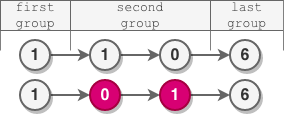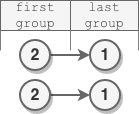LeetCode 2074 Reverse Nodes in Even Length Groups
You are given the
head of a linked list.The nodes in the linked list are sequentially assigned to non-empty groups whose lengths form the sequence of the natural numbers (
1, 2, 3, 4, ...). The length of a group is the number of nodes assigned to it. In other words,The
1<sup>st</sup> node is assigned to the first group.
The 2<sup>nd</sup> and the 3<sup>rd</sup> nodes are assigned to the second group.The
4<sup>th</sup>, 5<sup>th</sup>, and 6<sup>th</sup> nodes are assigned to the third group, and so on.Note that the length of the last group may be less than or equal to
1 + the length of the second to last group.Reverse the nodes in each group with an even length, and return the
head of the modified linked list.Example 1:

Input: head = [5,2,6,3,9,1,7,3,8,4]
Output: [5,6,2,3,9,1,4,8,3,7]
Explanation:
- The length of the first group is 1, which is odd, hence no reversal occurrs.
- The length of the second group is 2, which is even, hence the nodes are reversed.
- The length of the third group is 3, which is odd, hence no reversal occurrs.
- The length of the last group is 4, which is even, hence the nodes are reversed.
Example 2:

Input: head = [1,1,0,6]
Output: [1,0,1,6]
Explanation:
- The length of the first group is 1. No reversal occurrs.
- The length of the second group is 2. The nodes are reversed.
- The length of the last group is 1. No reversal occurrs.
Example 3:

Input: head = [2,1]
Output: [2,1]
Explanation:
- The length of the first group is 1. No reversal occurrs.
- The length of the last group is 1. No reversal occurrs.
Example 4:
Input: head = [8]
Output: [8]
Explanation: There is only one group whose length is 1. No reversal occurrs.
Constraints: The number of nodes in the list is in the range
[1, 10<sup>5</sup>].*
0 <= Node.val <= 10<sup>5</sup>题目大意:
把链表分成1,2,3..n大小的组。若该组大小为偶数,反转链表。
解题思路:
一开始考虑分奇偶组来处理,但忽略了最后一组也可能为偶数。用stack来,先做统计,若为偶数,就出栈且反转。
后来为了程序更加简洁,就独立一个函数出来按组处理。而每组用迭代将后续节点一个个加到上一组末节点和首节点之间。
解题步骤:
- 按组处理
- 每组先统计个数,如果为偶数,反转链表
start(group n) -> end(group n+1, head of group n+1 will become new tail after reversed) -> …
不断将end直接后面的节点加到start直接后面
start(group n) -> NodeA (新状态) -> … -> end(group n+1) -> NodeA (前状态) -> …
注意事项:
- 若最后一组不满为偶数,也要逆转。
- 反转链表时,个数为这组大小减一,因为该组的首节点不用反转。
Python代码:
1 | def reverseEvenLengthGroups(self, head: Optional[ListNode]) -> Optional[ListNode]: |
算法分析:
时间复杂度为O(n),空间复杂度O(1)。



